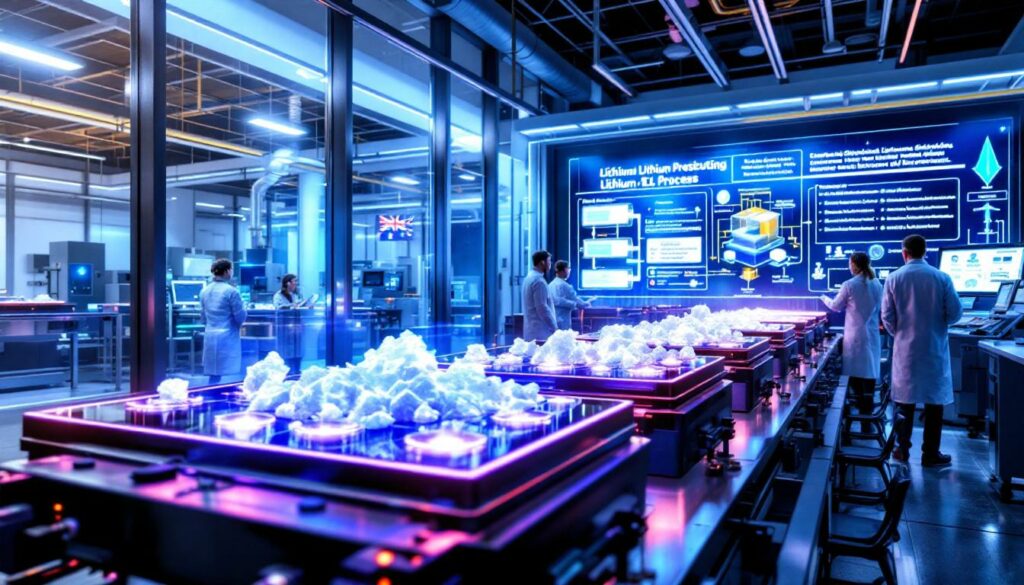Understanding the ELi Process: A Revolutionary Approach to Lithium Production
The ELi process represents a significant breakthrough in lithium processing technology, utilizing electricity rather than traditional chemical reagents to produce lithium hydroxide. This electrochemical approach fundamentally transforms how lithium compounds are manufactured by:
- Replacing large volumes of chemical reagents with electrical current
- Reducing environmental impact through decreased chemical usage
- Offering potential cost advantages over conventional chemical precipitation methods
- Creating a more streamlined production pathway for lithium hydroxide monohydrate (LHM) and lithium carbonate (LC)
According to Chris Reed, Managing Director of Neometals, "We are confident ELi can be an ideal complement to Rio Tinto's direct lithium extraction (DLE) technologies," highlighting the process's strategic value in the lithium production landscape.
What is the ELi Process and How Does it Work?
The ELi process fundamentally revolutionizes lithium hydroxide production by employing electricity instead of the large volumes of chemical reagents traditionally used in the industry. This innovative approach represents a paradigm shift in how battery-grade lithium processing compounds are manufactured.
Rather than relying on complex chemical precipitation methods that require substantial reagent inputs, the ELi technology harnesses electrochemical principles to selectively isolate and transform lithium compounds. This creates a more direct pathway from lithium-containing solutions to battery-grade materials.
The process promises significant cost reductions compared to conventional methods while simultaneously reducing environmental impacts through minimized chemical usage. By replacing chemical reactions with precise electrical control, the ELi process eliminates many intermediate steps that typically complicate lithium production.
Technical Foundations of the ELi Process
The electrochemical process works by applying controlled electrical current to lithium-containing solutions, triggering selective precipitation of lithium compounds. This approach eliminates many of the intermediate steps and chemical inputs required in traditional processing methods, resulting in a more efficient production pathway.
Reed Advanced Materials has developed this technology as a comprehensive solution that includes "detailed process design specifications, engineering schematics, and equipment lists" for implementation. The system is designed to integrate with existing lithium extraction technologies, particularly direct lithium extraction (DLE) methods being developed by companies like Rio Tinto.
While specific technical parameters such as voltage ranges, current densities, and electrode materials remain confidential, the technology has advanced sufficiently to warrant industrial-scale demonstration, targeting "Readiness Level 7" through upcoming development phases.
Why is Rio Tinto Partnering with Reed Advanced Materials?
The collaboration between mining giant Rio Tinto and Reed Advanced Materials (RAM) represents a strategic alignment of complementary capabilities to advance lithium processing technology. This partnership offers multiple advantages:
Strategic Benefits of the Collaboration
- Combines Rio Tinto's scale and development capabilities with RAM's innovative technology
- Leverages Rio Tinto's financial strength to accelerate technology readiness
- Creates potential synergies with Rio Tinto's direct lithium extraction (DLE) technologies
- Provides a pathway to enhance the value of Rio Tinto's lithium brine assets
- Establishes a framework for comprehensive technology evaluation and potential commercialization
Rio Tinto brings substantial resources to the partnership, including its experience with a C$7.6 million (£4.12m) investment in ore-sorting technology at its Lac Tio mine. This demonstrates the company's commitment to developing and implementing innovative mining and processing technologies.
Chris Reed emphasized that "Rio Tinto is a global leader in energy transition commodities with scale, development capabilities and financial strength," highlighting why the partnership makes strategic sense for both companies.
RAM's Position in the Lithium Technology Landscape
Reed Advanced Materials, as a joint venture between Neometals and Mineral Resources, brings specialized expertise in lithium processing innovation. The company has positioned itself as a technology provider rather than a direct producer, with plans to:
- License the ELi technology to lithium producers for royalty fees
- Provide comprehensive technology packages including process designs and engineering schematics
- Offer technical support services for implementation and operational optimization
This approach allows RAM to capitalize on its innovation while leveraging the operational expertise and resources of established mining companies like Rio Tinto. The licensing model creates potential for widespread adoption of the technology across multiple operations while generating ongoing revenue streams for RAM.
What Are the Key Components of the Rio Tinto-RAM Agreement?
The memorandum of understanding (MoU) between Rio Tinto and Reed Advanced Materials establishes a structured framework for collaboration on the ELi process development. While non-binding, it outlines several critical pathways for cooperation:
Evaluation and Testing Framework
- Extended testing protocols to assess ELi's performance under various conditions
- Potential negotiation of an evaluation license for Rio Tinto
- Exploration of funding mechanisms for optimization test work
- Process design updates based on testing outcomes
The agreement specifically targets advancing the ELi technology to "Readiness Level 7," which requires demonstration at scale. This structured approach ensures thorough validation before commercial implementation decisions are made.
Pathway to Commercial Implementation
- Potential detailed design and cost estimation for a demonstration plant in Argentina
- Steps to advance the technology to "Readiness Level 7" through future trials
- Framework for potential field trials at Rio Tinto's lithium assets
- Possible commercial agreement structure for implementing ELi at Rio Tinto operations
The proposed demonstration plant in Argentina represents a critical milestone, providing an opportunity to validate the technology's performance under real-world conditions and at a scale relevant to commercial operations. This staged approach mitigates risk while maintaining momentum toward commercial implementation.
How Does the ELi Process Compare to Conventional Lithium Processing?
The ELi technology represents a significant departure from traditional lithium processing methods, offering several potential advantages while addressing key industry challenges.
Advantages Over Conventional Methods
| Aspect | Conventional Chemical Precipitation | ELi Process |
|---|---|---|
| Chemical Usage | Requires large volumes of reagents | Minimizes chemical inputs through electrochemical approach |
| Environmental Impact | Higher chemical waste generation | Reduced chemical waste streams |
| Process Complexity | Multiple chemical reaction steps | Streamlined electrochemical process |
| Cost Structure | Higher reagent and handling costs | Potential for significant cost reduction |
| Scalability | Challenges with chemical handling at scale | Potentially more scalable electrical systems |
While specific efficiency metrics are not publicly disclosed, the technology promises to "significantly enhance the efficiency" of lithium hydroxide and carbonate production compared to conventional approaches. The electrochemical process creates a more direct pathway from lithium-containing solutions to battery-grade materials.
Industry Challenges Addressed
- Reduces dependence on chemical supply chains
- Decreases environmental footprint of lithium production
- Potentially lowers production costs in a competitive market
- Creates more efficient pathways from lithium resources to battery-grade materials
The ELi process addresses several critical pain points in conventional lithium processing, particularly the intensive use of chemical reagents and the associated handling, transportation, and waste management challenges. By shifting to an electrochemical approach, many of these challenges are minimized or eliminated entirely.
What Could This Mean for the Future of Lithium Production?
The development of the ELi process could have far-reaching implications for the lithium industry and the broader energy transition landscape.
Potential Industry Impact
- Reduced production costs could improve economics for lithium projects
- More environmentally sustainable processing could address regulatory and ESG concerns
- Integration with direct lithium extraction (DLE) technologies could unlock new resource types
- Streamlined production pathways could accelerate supply chain development
According to Chris Reed, the ELi technology has the potential to enhance "the value of [Rio Tinto's] Tier 1 portfolio," suggesting significant economic improvements for existing and future lithium assets. The integration with DLE technologies is particularly noteworthy, as it could create end-to-end solutions for efficient lithium production from previously challenging resources.
Broader Implications for Energy Transition
The advancement of more efficient lithium processing technologies directly supports the global shift toward electrification and renewable energy by:
- Potentially reducing battery material costs
- Accelerating production capacity for critical battery materials
- Improving the environmental profile of battery supply chains
- Creating more resilient and diverse lithium production pathways
By addressing both economic and environmental aspects of lithium production, the ELi process could help resolve the tension between rapidly scaling battery material production and minimizing environmental impacts. This balanced approach aligns with broader sustainability goals in the energy transition.
What Are the Next Steps for ELi Process Development?
For the ELi technology to reach commercial implementation, several critical development phases remain. The collaboration between Rio Tinto and RAM establishes a pathway through these stages:
Technology Readiness Advancement
- Extended performance testing under various operating conditions
- Optimization of process parameters and design specifications
- Demonstration plant development to validate performance at scale
- Field trials at actual lithium brine operations
The technology is currently advancing toward "Readiness Level 7," which requires demonstration at a scale representative of commercial operations. The partnership with Rio Tinto aims to accelerate this progression through structured testing and evaluation.
Commercial Implementation Roadmap
- Detailed economic assessment of full-scale implementation
- Integration planning with existing and planned lithium operations
- Development of licensing and technology transfer frameworks
- Establishment of commercial-scale design parameters
The proposed demonstration plant in Argentina represents a critical milestone on this pathway, providing validation of the technology's performance in a real-world context. Successful demonstration would pave the way for broader implementation across Rio Tinto's lithium assets and potential licensing to other producers.
How Does This Development Fit Within Rio Tinto's Broader Strategy?
Rio Tinto's interest in the ELi process aligns with the company's expanding focus on energy transition materials and technological innovation.
Strategic Alignment with Rio Tinto's Initiatives
The ELi collaboration complements Rio Tinto's other recent technology investments, including:
- C$7.6 million commitment to an industrial demonstration project at Lac Tio mine
- Exploration of ore sorting technology to improve efficiency and reduce environmental impact
- Development of direct lithium extraction (DLE) capabilities for brine resources
These investments demonstrate Rio Tinto's commitment to developing innovative technologies that can enhance operational efficiency, reduce environmental impacts, and create competitive advantages in energy transition materials.
Portfolio Enhancement Opportunities
Successful implementation of the ELi technology could enhance Rio Tinto's position in the lithium market by:
- Adding value to existing lithium brine assets
- Creating competitive advantages through proprietary processing capabilities
- Establishing leadership in sustainable lithium production technologies
- Diversifying the company's exposure to energy transition materials
The ELi process could be particularly valuable in conjunction with Rio Tinto's DLE technologies, creating an integrated solution for efficient lithium production from brine resources. This synergistic approach could significantly strengthen Rio Tinto's competitive position in the rapidly evolving lithium market.
What Are the Potential Economic Benefits of the ELi Process?
The economic advantages of the ELi process could be substantial, potentially reshaping cost structures across the lithium production landscape.
Cost Reduction Potential
While specific figures remain confidential, the ELi process promises significant cost advantages through:
- Reduced chemical reagent procurement and handling costs
- Streamlined processing with fewer operational steps
- Lower waste management requirements
- Potentially higher recovery rates of lithium from source materials
These factors collectively contribute to what Reed Advanced Materials describes as "significant cost reductions compared with the conventional chemical precipitation process used in the industry." Such cost advantages could be particularly valuable in the competitive lithium market, where production efficiency is a key differentiator.
Value Creation Opportunities
Beyond direct production cost savings, the ELi technology creates additional value through:
- Potential for premium pricing for more sustainably produced lithium
- Licensing revenue streams for technology providers
- Reduced capital intensity for new lithium hydroxide production facilities
- Enhanced project economics for previously marginal lithium resources
For Reed Advanced Materials, the licensing model represents a capital-efficient approach to monetizing their innovation, with royalty fees providing ongoing revenue as the technology is deployed across multiple operations.
What Environmental Advantages Does the ELi Process Offer?
The environmental profile of the ELi process represents one of its most significant potential advantages in an increasingly ESG-focused industry.
Environmental Impact Reduction
- Minimizes chemical reagent usage and associated transportation emissions
- Reduces waste streams from processing operations
- Decreases water usage compared to conventional methods
- Lowers overall carbon footprint of lithium production when powered by renewable electricity
These environmental benefits address growing concerns about the sustainability of lithium production, particularly as demand scales rapidly to support electrification and renewable energy storage.
Alignment with Sustainability Goals
The ELi process supports broader sustainability objectives by:
- Enabling more environmentally responsible lithium production
- Supporting the development of cleaner battery supply chains
- Reducing the environmental trade-offs associated with energy transition materials
- Creating pathways for more sustainable scaling of lithium production
As regulatory requirements and market expectations for sustainability continue to strengthen, technologies like the ELi process that reduce environmental impacts while maintaining economic viability will become increasingly valuable to lithium producers. Furthermore, these advancements align with recent lithium industry innovations that are transforming global production capabilities.
FAQ: Understanding the ELi Process and Rio Tinto Partnership
How does the ELi process differ from traditional lithium extraction methods?
The ELi process uses electrochemical principles rather than chemical precipitation to produce lithium compounds. This approach replaces large volumes of chemical reagents with electrical current, potentially reducing costs, environmental impact, and process complexity.
What stage of development is the ELi technology currently in?
The technology is advancing toward "Readiness Level 7," which requires demonstration at scale. The partnership with Rio Tinto aims to accelerate this development through extended testing, potential demonstration plant development in Argentina, and eventual field trials.
How might this technology impact lithium prices?
If successfully commercialized, the ELi process could potentially lower production costs for lithium hydroxide and lithium carbonate. This might enable more competitive pricing in the market, though actual price impacts would depend on broader supply-demand dynamics in the lithium sector.
What is the significance of Rio Tinto's involvement in this technology?
Rio Tinto brings substantial financial resources, development capabilities, and a portfolio of lithium assets that could benefit from the technology. Their involvement signals industry recognition of the potential value of the ELi process and provides a pathway to commercial-scale implementation.
How does this technology fit with direct lithium extraction (DLE)?
The ELi process is complementary to DLE technologies. While DLE focuses on extracting lithium from brines or other sources, the ELi process addresses the conversion of lithium into battery-grade compounds like lithium hydroxide. Together, these technologies could create more efficient pathways from resource to battery material. Recent advancements in Argentine lithium brine insights have highlighted the growing importance of these complementary technologies.
Further Exploration:
Readers interested in learning more about innovations in lithium processing can also explore related educational content available from Mining Technology at https://www.mining-technology.com/news/reed-advanced-materials-mou-rio-tinto-eli-process/. This resource offers additional perspectives on developments in lithium production technologies.
For more in-depth analysis of emerging extraction methods, the article on geothermal lithium extraction showcases additional innovations in the field, while updates on the Thacker Pass lithium project provide context on how conventional mining approaches are evolving alongside new technologies like the ELi process.
Additional information about the RAM-Rio Tinto collaboration can be found in Neometals' official announcement available at https://company-announcements.afr.com/asx/nmt/1fc68bfa-521c-11f0-9565-6a1e64a102a0.pdf.
Are You Ready to Transform Your Lithium Investments?
Unlock real-time alerts on game-changing mineral discoveries featured on the Australian Stock Exchange, powered by Discovery Alert’s unique Discovery IQ model. Immerse yourself in our historic examples of successful returns by visiting the Discoveries page, and start your 30-day free trial today for an edge in the market.




